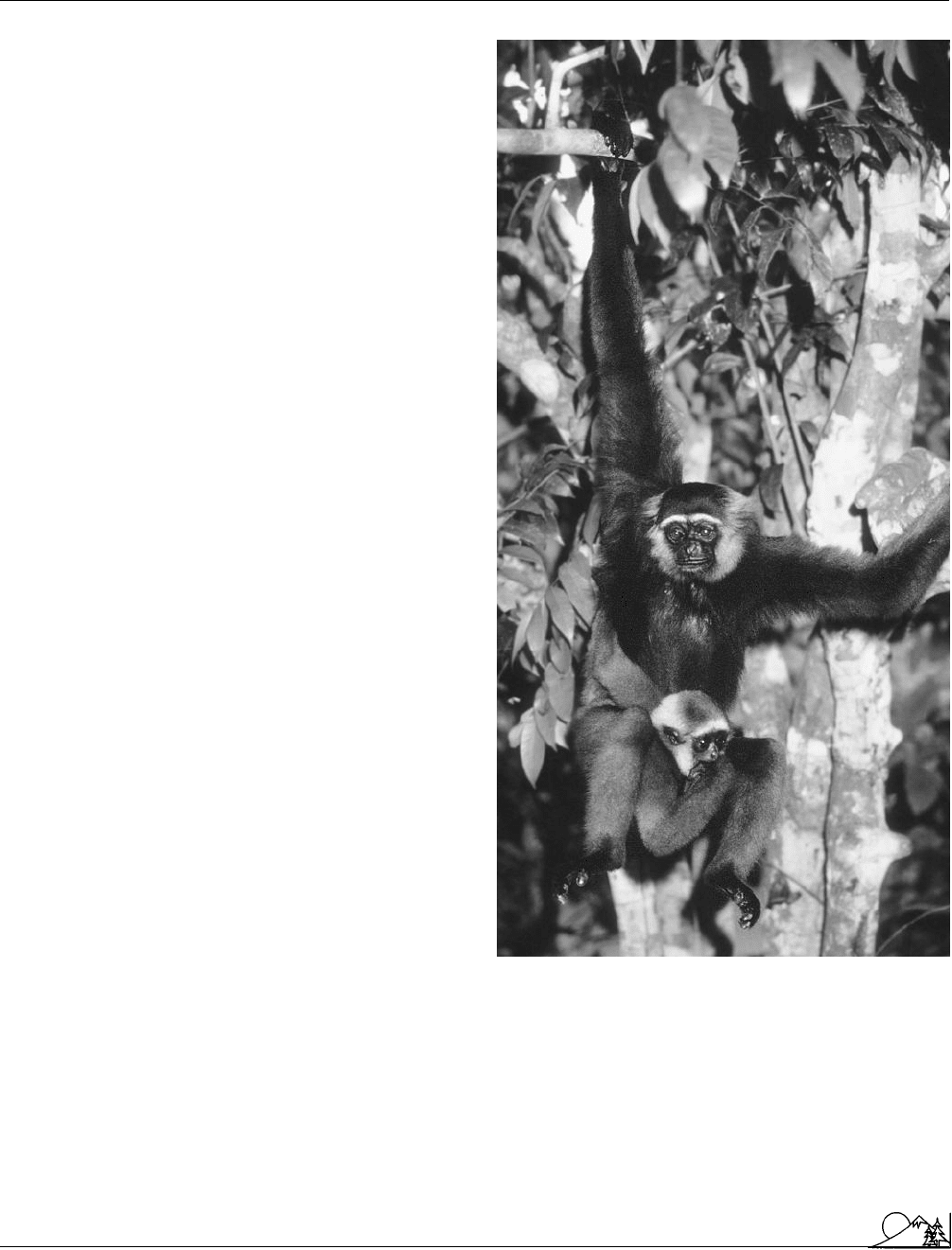Environmental Encyclopedia
Подождите немного. Документ загружается.


Environmental Encyclopedia 3
Giardia
The anatomy of the giant panda indicates that it is a
carnivore, however, its diet consists almost entirely of bam-
boo, whose cellulose cannot be digested by the panda. Since
the giant panda obtains so little
nutrient
value from the
bamboo, it must eat enormous quantities of the plant each
day, about 35 lb (16 kg) of leaves and stems, in order to
satisfy its energy requirements. Whenever possible, it feeds
solely on the young succulent shoots of bamboo, which,
being mostly water, requires it to eat almost 90 lb (41 kg)
per day. This translates into 10–12 hours per day that pandas
spend eating. Giant pandas have been known to supplement
their diet with other plants such as horsetail and pine bark,
and they will even eat small animals, such as rodents, if they
can catch them, but well over 95% of their diet consists of
the bamboo plant.
Bamboo normally grows by sprouting new shoots from
underground rootstocks. At intervals from 40 to 100 years,
the bamboo plants blossom, produce seeds, then die. New
bamboo then grows from the seed. In some regions it may
take up to six years for new plants to grow from seed and
produce enough food for the giant panda. Undoubtedly this
has produced large shifts in panda population size over the
centuries. Within the last quarter century, two bamboo flow-
erings have caused the starvation of nearly 200 giant pandas,
a significant portion of the current population. Although
the wildlife reserves contain sufficient bamboo, much of the
vast bamboo forests of the past have been destroyed for
agriculture, leaving no alternative areas to move to should
bamboo blossoming occur in their current range.
Low
fecundity
and limited success in captive breeding
programs in zoos does not bode well for replenishing any
significant losses in the wild population. Although there are
150 pandas in captivity, only about 28% are breeding. In
1999, the first giant panda to live more than a few days
was born in captivity. For the time being, the giant panda
population appears stable, a positive sign for one of the
world’s scarcest and most popular animals.
[Eugene C. Beckham]
R
ESOURCES
B
OOKS
Nowak, R. M., ed. Walker’s Mammals of the World. 5th ed. Baltimore: Johns
Hopkins University Press, 1991.
P
ERIODICALS
“China goes High Tech to Help Panda Population.” USA Today, August
13, 2001.
Drew, L. “Are We Loving the Panda to Death?” National Wildlife 27
(1989): 14–17.
“Pandas Still under Threat of Extinction.” USA Today, February 16, 2001.
637
Giardia. (Photograph by J. Paulin. Visuals Unlimited.
Reproduced by permission.)
Giardia
Giardia is the genus (and common) name of a protozoan
parasite in the phylum Sarcomastigophora. It was first de-
scribed in 1681 by Antoni van Leeuwenhoek (called “The
Father of Microbiology"), who discovered it in his own stool.
The most common
species
is Giardia intestinalis (also called
lamblia), which is a fairly common parasite found in humans.
The disease it causes is called giardiasis.
The trophozoite (feeding) stage is easily recognized
by its pear-shaped, bilaterally-symmetrical form with two
internal nuclei and four pairs of external flagella; the thin-
walled cyst (infective) stage is oval. Both stages are found
in the upper part of the small intestine in the mucosal lining.
The anterior region of the ventral surface of the troph stage
is modified into a sucking disc used to attach to the host’s
abdominal epithelial tissue. Each troph attaches to one epi-
thelial cell. In extreme cases, nearly every cell will be covered,
causing severe symptoms. Infection usually occurs through
drinking contaminated water. Symptoms include diarrhea,
flatulence (gas), abdominal cramps, fatigue, weight loss, an-
orexia, and/or nausea and may last for more than five days.
Diagnosis is usually done by detecting cysts or trophs of this
parasite in fecal specimens.
Giardia has a worldwide distribution. It is more com-
mon in warm, tropical regions than in cold regions. Hosts
include
frogs
, cats, dogs, beaver, muskrat, horses, and hu-
mans. Children as well as adults can be affected, although it
is more common in children. It is highly contagious. Normal
infection rate in the United States ranges from 1.5 to 20%. In
one case involving scuba divers from the New York City police
and fire fighters, 22–55% were found to be infected, presum-
ably after they accidentally drank contaminated water in the
local rivers while diving. In another case, an epidemic of giar-

Environmental Encyclopedia 3
Gibbons
diasis occurred in Aspen, Colorado, in 1965 during the popu-
lar ski season and 120 people were infected. Higher infection
rates are common in some areas of the world, including Iran
and countries in Sub-Saharan Africa.
Giardia can typically withstand sophisticated forms of
sewage treatment
, including
filtration
and
chlorination
.
It is therefore hard to eradicate and may potentially increase
in polluted lakes and rivers. For this reason, health officials
should make concerted efforts to prevent contaminated feces
from infected animals (including humans) from entering
lakes used for drinking water.
The most effective treatment for giardiasis is the drug
Atabrine (quinacrine hydrochloride). Adult dosage is 0.1 g
taken after meals three times each day. Side effects are rare
and minimal. See also Cholera; Coliform bacteria
[John Korstad]
R
ESOURCES
B
OOKS
Markell, E. K., M. Voge, and D. T. John. Medical Parasitology. 7th ed.
Philadelphia: W. B. Saunders, 1992.
Schmidt, G. D., and L. S. Roberts. Foundations of Parasitology. 4th ed. St.
Louis: Times Mirror/Mosby, 1989.
U.S. Department of Health and Human Services. Health Information for
International Travel. Washington, DC: U.S. Government Printing Of-
fice, 1991.
Gibbons
Gibbons (genus Hylobates, meaning “dweller in the trees")
are the smallest members of the ape family which also in-
cludes gorillas,
chimpanzees
, and orangutans. They spend
most of their lives at the tops of trees in the jungle, eating
leaves and fruit. They are extremely agile, swinging at speeds
of 35 mph (56 km/h) with their long arms on branches to
move from tree to tree. The trees can even be 50 ft (15 m)
apart. They have no tails and are often seen walking upright
on tree branches. Gibbons are known for their loud calls
and songs, which they use to announce their territory and
warn away others. They are devoted parents, raising usually
one or two offspring at a time and showing extraordinary
affection in caring for them. Conservationists and animal
protectionists who have worked with gibbons describe them
as extremely intelligent, sensitive, and affectionate.
Gibbons have long been hunted for food, for medical
research, and for sale as pets and
zoo
specimens. A common
method of collecting them is to shoot the mother and capture
the nursing or clinging infant, if it is still alive. The
mortality
rate in collecting and transporting gibbons to areas where
they can be sold is extremely high. This, coupled with the
fact that their jungle
habitat
is being destroyed at a rate of
638
A gibbon. (©Breck P. Kent/JLM Visuals. Reproduced by
permission.)
32 acres (13 ha) per minute, has resulted in severe depletion
of their numbers.
Gibbons are found in southeast Asia, China, and In-
dia, and nine
species
are recognized. All nine species are
considered endangered by the
U.S. Department of the Inte-
rior
and are listed in the most endangered category of the

Environmental Encyclopedia 3
Lois Marie Gibbs
Convention on International Trade in Endangered Spe-
cies of Wild Fauna and Flora
(CITES).
IUCN—The World
Conservation Union
considers three species of gibbon to
be endangered and two species to be vulnerable. Despite the
ban on international trade in gibbons conferred by listing
in Appendix I of CITES, illegal trade in gibbons, particularly
babies, continues on a wide scale in markets throughout Asia.
[Lewis G. Regenstein]
R
ESOURCES
B
OOKS
Benirschke, K. Primates: The Road to Self-sustaining Populations. New York:
Springer-Verlag, 1986.
Preuschoft, H., et al. The Lesser Apes: Evolutionary and Behavioral Biology.
Edinburgh: Edinburgh University Press, 1984.
O
THER
International Center for Gibbon Studies. [cited May 2002]. <http://www.gib-
boncenter.org>.
Lois Marie Gibbs (1951 – )
American environmentalist and community organizer
An activist dedicated to protecting communities from haz-
ardous wastes, Lois Gibbs began her political career as a
housewife and homeowner near the
Love Canal
, New York.
She was born in Buffalo on June 25, 1951, the daughter of
a bricklayer and a full-time homemaker. Gibbs was 21 and
a mother when she and her husband bought their house
near a buried dump containing hazardous materials from
industry and the military, including wastes from the research
and manufacture of chemical weapons.
From the time the first articles about Love Canal
began appearing in newspapers in 1978, Gibbs has petitioned
for state and federal assistance. She began when she discov-
ered the school her son was attending had been built directly
on top of the buried canal. Her son had developed epilepsy
and there were many similar, unexplained disorders among
other children at the school, yet the superintendent was
refusing to transfer anyone. The New York State Health
Department then held a series of public meetings in which
officials appeared more committed to minimizing the com-
munity perception of the problem than to solving the prob-
lem itself. The governor made promises he was unable to
keep, and Gibbs herself was flown to Washington to appear
at the White House for what she later decided was little
more than political grandstanding. In the book she wrote
about her experience, Love Canal: My Story, Gibbs describes
her frustration and her increasing disillusionment with gov-
639
ernment, as the threats to the health of both adults and
children in the community became more obvious and as it
became clearer that no one would be able to move because
no one could sell their homes.
While state and federal agencies delayed, the media
took an increasing interest in their plight, and Gibbs became
more involved in political action. To force federal action,
Gibbs and a crowd of supporters took two officers from
the
Environmental Protection Agency
(EPA) hostage. A
group of heavily armed FBI agents occupied the building
across the street and gave her seven minutes before they
stormed the offices of the Homeowners’ Association, where
the men were being held. With less than two minutes left
in the countdown, Gibbs appeared outside and released the
hostages in front of a national television audience. By the
middle of the next week, the EPA had announced that
the Federal Disaster Assistance Administration would fund
immediate evacuation for everyone in the area.
But the families who left the Love Canal area still
could not sell their homes, and Gibbs fought to force the
federal government to purchase them and underwrite low-
interest loans. After she accused President Jimmy Carter of
inaction on a national talk show, in the midst of an ap-
proaching election, he agreed to purchase the homes. But
he refused to meet with her to discuss the loans. Carter
signed the appropriations bill in a televised ceremony at the
Democratic National Convention in New York City, and
Gibbs simply walked onstage in the middle of it and repeated
her request for mortgage assistance. The president could do
nothing but promise his political support, and the assistance
she had been asking for was soon provided.
Gibbs was divorced soon after her family left the Love
Canal area. She moved to Washington D.C. with her two
children and founded the Citizen’s Clearinghouse for Haz-
ardous Wastes in 1981 (later renamed the Center for Health,
Environment and Justice in 1997). Its purpose is to assist
communities in fighting toxic waste problems, particularly
plans for toxic waste dumping sites, and the organization
has worked with over 7,000 neighborhood and community
groups. Gibbs has also published Dying from Dioxin, A Citi-
zen’s Guide to Reclaiming Our Health and Rebuilding Democ-
racy. She has appeared on many television and radio shows
and has been featured in hundreds of newspaper and maga-
zine articles. Gibbs has also been the subject of several docu-
mentaries and television movies. She often speaks at confer-
ences and seminars and has been honored with numerous
awards, including the prestigious Goldman Environmental
Prize in 1991. Because of Gibbs’ activist work, no commer-
cial sites for hazardous wastes have been opened in the
United States since 1978.
[Lewis G. Regenstein and Douglas Smith]

Environmental Encyclopedia 3
Gill nets
Lois Gibbs at her desk during her fight to win
permanent relocation for the families living at
Love Canal. (Corbis-Bettmann. Reproduced by per-
mission.)
R
ESOURCES
B
OOKS
Gibbs, L. Love Canal: My Story. Albany: State University of New York
Press, 1982.
Wallace, A. Eco-Heroes. San Francisco: Mercury House, 1993.
Gill nets
Gill nets are panels of diamond-shaped mesh netting used
for catching fish. When fish attempt to swim through the
net their gill covers get caught and they cannot back out.
Depending on the
target species
, different mesh sizes are
available for use. The top line of the net has a series of floats
attached for buoyancy, and the bottom line has
lead
weights
to hold the net vertically in the water column.
Gill nets have been in use for many years. They became
popular in commercial fisheries in the nineteenth century,
evolving from cotton twine netting to the more modern
nylon twine netting and monofilament nylon netting. As
with many other aspects of
commercial fishing
, the use of
gill nets has developed from minor utilization to a major
environmental issue. Coupled with
overfishing
, the use of
gill nets has caused serious concern throughout the world.
640
Because gill nets are so efficient at catching fish, they
are just as efficient at catching many non-target
species
,
including other fishes,
sea turtles
, sea mammals, and sea
birds. Gill nets have been used extensively in the commercial
fishery for
salmon
and capelin (Mallotus villosus).
Dolphins
,
seals
, and sea otters (Enhydra lutris) get tangled in the nets,
as do diving sea birds such as murres, guillemots, auklets,
and puffins that rely on capelin as a mainstay in their diet.
Sea turtles are also entangled and drown.
The problem has gotten worse over the last decade
with the introduction and extensive use, primarily by foreign
fishing fleets, of drift nets. Described as “the most indiscrim-
inate killing device used at sea,” drift nets are monofilament
gill nets up to 40 mi (64 km) in length. Left at sea for several
days and then hauled on board a fishing vessel, these drift
nets contain vast numbers of dead marine life, besides the
target species, that are simply discarded over the side of the
boat. The outrage expressed regarding these “curtains of
death” led to a United Nations resolution banning their use
in commercial fisheries after the end of 1992. Commercial
fishermen who use other types of nets for catching fish, such
as the purse seines used in the tuna fishing industry and the
bag trawls used in the shrimping industry, have modified
their nets and fishing techniques to attempt to eliminate the
killing of dolphins and sea turtles, respectively. Unfortu-
nately, such modifications of gill nets are nearly impossible
due to the nets’ design and the way these nets are used. See
also Turtle excluder device
[Eugene C. Beckham]
R
ESOURCES
P
ERIODICALS
Norris, K. “Dolphins in Crisis.” National Geographic 182 (1992): 2–35.
GIS
see
Geographic information systems
Glaciation
The covering of the earth’s surface with glacial ice. The term
also includes the alteration of the surface of the earth by
glacial
erosion
or deposition. Due to the passage of time,
ice erosion can be almost unidentifiable; the
weathering
of hard rock surfaces often eliminates minor scratches and
other evidence of such glacial activities as the carving of deep
valleys. The evidence of deposition, known as depositional
imprints, can vary. It may consist of specialized features a
few meters above the surrounding terrain, or it may consist

Environmental Encyclopedia 3
Henry A. Gleason
of ground materials several meters in thickness covering wide
areas of the landscape.
Only 10% of the earth’s surface is currently covered
with glacial ice, but it is estimated that 30% had been covered
with glacial ice at some time. During the last major glacial
period, most of Europe and more than half of the North
American continent were covered with ice. The glacial ice
of modern day is much thinner than it was in the
ice age
,
and the majority of it (85%) is found in
Antarctica
. About
11% of the remaining glacial ice is in Greenland, and the
rest is scattered in high altitudes throughout the world.
Moisture and cold temperatures are the two main fac-
tors for the formation of glacial ice. Glacial ice in Antarctica
is the result of relatively small quantities of snow deposition
and low loss of ice because of the cold
climate
. In the middle
and low latitudes where the loss of ice, known as ablation,
is higher, snowfall tends to be much higher and the glaciers
are able overcome ablation by generating large amounts of
ice. These types of systems tend to be more active than the
glaciers in Antarctica, and the most active of these are often
located at high altitudes and in the path of prevailing winds
carrying marine moisture.
The
topography
of the earth has been shaped by glaci-
ation. Hills have been reduced in height and valleys created
or filled in the movement of glacial ice. Moraine is a French
term used to describe the ridges and earthen dikes formed near
the edges of regional glaciers. Ground moraine is material that
accumulates beneath a glacier and has low-relief characteris-
tics, and end moraine is material that builds up along the ex-
tremities of a glacier in a ridge-like appearance.
In England, early researchers found stones that were
not common to the local ground rock and decided they must
have “drifted” there, carried by icebergs on water. Though
geology has changed since that time, the term remains and
all deposits made by glacial ice are usually identified as drift.
These glacial deposits, also known as till, are highly varied
in composition. They can be a fine grained deposit, or very
coarse with rather large stones present, or a combination
of both.
Rock and other soil-like debris are often crushed and
ground into very small particles, and they are commonly
found as
sediment
in waters flowing from a glacial mass.
This material is called glacial flour, and it is carried down-
stream to form another kind of glacial deposit. During cer-
tain cold, dry periods of the year winds can pick up portions
of this deposit and scatter it for miles. Many of the different
soils in the American “Corn Belt” originated in this way,
and they have become some of the more important agricul-
tural soils in the world.
[Royce Lambert]
641
R
ESOURCES
B
OOKS
Flint, R. F. Glacial and Pleistocene Geology. New York: Wiley, 1972.
Henry A. Gleason (1882 – 1975)
American ecologist
Henry A. Gleason was a half generation after that small
group of midwesterners who founded
ecology
as a discipline
in the United States. He was a student of
Stephen Forbes
and his early work in ecology was influenced strongly by
Cowles and
Frederic E. Clements
. He did later, however, in
1935, claim standing—bowing only to Cowles and Clements
and for some reason not including Forbes—as “the only
other original ecologist in the country.” And he was original.
His work built on that of the founders, but he quickly and
actively questioned their ideas and concepts, especially those
of Clements, in the process creating controversy and polar-
ization in the ecological community. Gleason called himself
an “ecological outlaw” and probably over-emphasized his
early lack of acceptance in ecology, but in a resolution of
respect from the Ecological Society of America after his
death, he was described as a revolutionary and a heretic for
his skepticism toward ’established’ ideas in ecology. Stanley
Cain said that Gleason was never “impressed nor fooled by
the philosophical creations of other ecologists, for he has
always tested their ideas concerning the association,
succes-
sion
, the climax, environmental controls, and
biogeogra-
phy
against what he knew in
nature
.” Gleason was a critical
rather than negative thinker and never fully rejected the
utility of the idea of community, but the early marginaliza-
tion of his ideas by mainstream ecologists, and the contro-
versy they created, may have played a role in his later concen-
tration on taxonomy over ecology.
He claimed that if plant associations did exist, they
were individualistic and different from area to area, even
where most of the same species were present. Gleason did
clearly reject, however, Clements’ idea of a monoclimax,
proclaiming that “the Clementsian concept of succession, as
an irreversible trend leading to the climax, was untenable.”
His field observations also led him to repudiate Clements’
organismic concept of the plant community, asking “are we
not justified in coming to the general conclusion, far removed
from the prevailing opinion, that an association is not an
organism?” He went on to say that it is “scarcely even a
vegetation unit.” He also pointed out the errors in ’Raunki-
aer’s Law,’ on frequency distribution, which as Robert McIn-
tosh noted, was “widely interpreted [in early ecology] as
being a fundamental community characteristic indicating
homogeneity,” and questioned Jaccard’s comparison of two
communities through a coefficient of similarity that Gleason

Environmental Encyclopedia 3
Henry A. Gleason
believed unduly gave as much weight to rare as to common
species.
Gleason’s own approach to the study of vegetation
emerged from his skills as a floristic botanist, an approach
rejected as “old botany” by the founders of ecology. As
Nicolson suggests, “a floristic approach entailed giving pri-
macy to the study of the individual plants and their species.
This was the essence of [Gleason’s] individualistic concept.”
In hindsight, somewhat ironically then, Gleason used old
botany to create a new alternative to what had quickly be-
come dogma in ecology, the centrality of the idea that units
of vegetation were real, that the plant association was indis-
pensable to an ecological approach.
Clements was more accepted in the early part of the
twentieth century than Gleason, though many ecologists at
the time considered both too extreme, just in opposite ways.
Today, Clements’ theories remain out of favor and some of
Gleason’s have been revived, though not all of them. Con-
trary to his own observations, he was persuaded that plants
are distributed randomly, at least over small areas, which is
seldom if ever the case, though he later backed away from
this assertion. He could not accept the theory of continental
drift, stating that “the theory requires a shifting of the loca-
tion of the poles in a way which does considerable violence
to botanical and geological facts,” and therefore should have
few adherents among botanists.
Despite Gleason’s skepticism about some of Clements’
major ideas, the older botanist was a major influence, espe-
cially early in Gleason’s career. Especially influential was
Clements’ rudimentary development of the quadrat method
of sampling vegetation, which shaped Gleason’s approach
to field work; Gleason took the method much further than
Clements, and though not trained in mathematics, was the
first ecologist to employ a number of quantitative approaches
and methods. As McIntosh demonstrated, Gleason, follow-
ing Forbes lead in aquatic ecology “was clearly one of the
earliest and most insightful proponents of the use of quanti-
tative methods in terrestrial ecology.”
Gleason was born in the heart of the area where ecol-
ogy first flourished in the United States. His interest in
vegetation and his contributions to ecology were both stimu-
lated by growing up in and doing research on the dynamics
of the prairie-forest border. He won bachelor’s and master’s
degrees from the University of Illinois and a Ph.D. from
Columbia University. He returned to the University of Illi-
nois as an instructor in botany (1901–1910), where he
worked with Stephen Forbes at one of the major American
centers of ecological research at the time. In 1910, he moved
to the University of Michigan (1910) and while in Ann
Arbor, married Eleanor Mattei. Then, in 1919, he moved
to the New York Botanical Garden, where he spent the rest
of his career, sometimes (reluctantly) as an administrator,
642
always as a research taxonomist. He retired from the Garden
in 1951.
Moving out of the Midwest, Gleason also moved out
of ecology. Most of his work at the Botanic Garden was
taxonomic. He did some ecological work, such as a three-
month ecological survey of Puerto Rico in 1926, and a re-
statement of his “individualistic concept of the plant associa-
tion, (also in 1926 and also in the Bulletin of the Torrey
Botanical Club), in which he posed what Nicolson described
as “a radical challenge” to the basis of contemporary ecologi-
cal practice. Gleason’s challenge to his colleagues and critics
in ecology was to “demolish our whole system of arrangement
and classification and start anew with better hope of success.”
His reasoning was that ecologists had “attempted to arrange
all our facts in accordance with older ideas, and have come
as a result into a tangle of conflicting ideas and theories.”
He anticipated twenty-first century thinking that identifica-
tion on the ground of community and ecosystem as ecological
units is arbitrary, noting that vegetation was too continuously
varied to identify recurrent associations. He claimed, for
example, that “no ecologist would refer the alluvial forests
of the upper and lower Mississippi to the same association,
yet there is no place along their whole range where one
can logically mark a boundary between them. As Mcintosh
suggests, “one of Gleason’s major contributions to ecology
was that he strove to keep the conceptual mold from harden-
ing prematurely.”
In his work as a taxonomist for the Garden, Gleason
traveled as a plant collector, becoming what he described as
“hooked” on tropical American botany, specializing in the
large family of melastomes, tropical plants ranging from
black mouth fruits to handsome cultivated flowers, a group
which engaged him for the rest of his career. His field work,
on this family but especially many others, was reinforced by
extensive study and identification on material collected by
others and made available to him at the Garden.
A major assignment during his New York years, em-
blematic of his work as a taxonomist, was a revision of the
Britton and Brown Illustrated Flora of the Northeastern United
States (1952) which Maguire describes as a “heavy duty [that]
intervened and essentially brought to a close Gleason’s excel-
lent studies of the South American floras and [his] detailed
inquiry into the Melastomataceae...this great work...occu-
pied some ten years of concentrated, self-disciplined atten-
tion.” He did publish a few brief pieces on the melastomes
after the Britton and Brown, and also two books with Arthur
Cronquist, Manual of Vascular Plants of Northeastern United
States and Adjacent Canada (1963) and the more general The
Natural Geographyof Plants (1964). The latter, though co-
authored, was an overt attempt by Gleason to summarize a
life’s work and make it accessible to a wider public.

Environmental Encyclopedia 3
Glen Canyon Dam
Gleason’s early ecological work on species-area rela-
tions, the problem of rare species, and his extensive taxo-
nomic work all laid an initial base for contemporary concern
among biologists (especially) about the threat to the earth’s
bio-diversity. Gleason wrote that analysis of “the various
species in a single association would certainly show that
their optimum environments are not precisely identical,” a
foreshadowing of later work on niche separation.
McIntosh claimed in 1975 that Gleason’s individual-
istic concept “must be seen not simply as one of historical
interest but very likely as one of the key concepts of modern
and, perhaps, future ecological thought.” A revival of Glea-
son’s emphasis on the individual at mid-twentieth century
became one of the foundations for what some scientists in
the second half of the twentieth century called a “new ecol-
ogy,” one that rejects imposed order and system and empha-
sizes the chaos, the randomness, the uncertainty and the
unpredictability of natural systems. A call for ’adaptive’ re-
source and environmental management policies flexible
enough to respond to unpredictable change in individually
variant natural systems is one outgrowth of such changes in
thinking in ecology and the
environmental sciences
.
[Gerald L. Young]
F
URTHER
R
EADING
B
OOKS
Gleason, H. A. “Twenty-Five Years of Ecology, 1910–1935.” Vol. 4, Mem-
oirs, Brooklyn Botanic Garden. Brooklyn: Brooklyn Botanic Garden, 1936.
P
ERIODICALS
Cain, Stanley A. “Henry Allan Gleason: Eminent Ecologist 1959.” Bulletin
of the Ecological Society of America 40, no. 4 (December 1959): 105–110.
Gleason, H. A. “Delving Into the History of American Ecology—Reprint
of 1952 Letter to C. H. Muller.” The Bulletin of the Ecological Society of
America 56, no. 4 (December 1975): 7–10.
Maguire, Bassett. “Henry Allan Gleason—1881–1975.” Bulletin of the Tor-
rey Botanical Club 102, no. 5 (September/October 1975): 274–282.
McIntosh, Robert P. “H.A. Gleason—"Individualistic Ecologist” 1882–
1975: His Contributions to Ecological Theory.” Bulletin of the Torrey Botan-
ical Club 102, no. 5 (September/October 1975): 253–273.
Nicolson, Malcolm. “Henry Allan Gleason and the Individualistic Hypoth-
esis: The Structure of a Botanist’s Career.” The Botanical Review 56, no.
2 (April/June 1990): 91–161.
Glen Canyon Dam
Until 1963, Glen Canyon was one of the most beautiful
stretches of natural scenery in the American West. The
canyon had been cut over thousands of years as the
Colorado
River
flowed over sandstone that once formed the floor of
an ancient sea. The colorful walls of Glen Canyon were
often compared to those of the Grand Canyon, only about
50 mi (80 km) downstream.
643
Humans have long seen more than beauty in the can-
yon, however. They have envisioned the potential value of
a water
reservoir
that could be created by damming the
Colorado. In a region where water can be as valuable as
gold, plans for the construction of a giant
irrigation
project
with water from a Glen Canyon dam go back to at least 1850.
Flood control was a second argument for the construc-
tion of such a dam. Like most western rivers, the Colorado
is wild and unpredictable. When fed by melting snows and
rain in the spring, its natural flow can exceed 300,000 ft
4
(8,400 m
4
) per second. At the end of a hot dry summer,
flow can fall to less than 1% of that value. The river’s water
temperature can also fluctuate widely, by more than 36°F
(20°C) in a year. A dam in Glen Canyon held the promise
of moderating this variability.
By the early 1900s, yet a third argument for building
the dam was proposed—the generation of hydroelectric
power. Both the technology and the demand were reaching
the point that power generated at the dam could be supplied
to Phoenix, Los Angeles, San Diego, and other growing
urban areas in the Far West.
Some objections were raised in the 1950s when con-
struction of a Glen Canyon Dam was proposed, and environ-
mentalists fought to protect this unique natural area. The
1950s and early 1960s were not, however, an era of high
environmental sensitivity, and plans for the dam eventually
were approved by the U. S. Congress. Construction of the
dam, just south of the Utah-Arizona border, was completed
in 1963 and the new lake it created, Lake Powell, began to
develop. Seventeen years later, the lake was full holding a
maximum of 27 million acre-feet of water.
The environmental changes brought about by the dam
are remarkable. The river itself has changed from a muddy
brown color to a clear crystal blue as the sediments it carries
are deposited behind the dam in Lake Powell.
Erosion
of
river banks downstream from the dam has lessened consider-
ably as spring floods are brought under control. Natural
beaches and sandbars, once built up by deposited
sediment
,
are washed away. River temperatures have stabilized at an
annual average of about 50°F (10°C). These physical changes
have brought about changes in
flora
and
fauna
also. Four
species
of fish native to the Colorado have become extinct,
but at least 10 species of birds are now thriving where they
barely survived before. The
biotic community
below the
dam is significantly different from what it was before con-
struction.
During the 1980s, questions about the dam’s operation
began to grow. A number of observers were especially con-
cerned about the fluctuations in flow through the dam, a
pattern determined by electrical needs in distant cities. Dur-
ing peak periods of electrical demand, operators increase the
flow of water though the dam to a maximum of 30,000 ft
4

Environmental Encyclopedia 3
Global Environment Monitoring System
(840 m
4
) per second. At periods of low demand, that flow
may be reduced to 1,000 ft
4
(28 m
4
) per second. As a result
of these variations, the river below the dam can change by
as much as 13 ft (4 m) in height in a single 24-hour period.
This variation can severely damage riverbanks and can have
unsettling effects on
wildlife
in the area as, for example,
fish are stranded on the shore or swept away from spawning
grounds. River-rafting is also severely affected by changing
river levels as rafters can never be sure from day to day what
water conditions they may encounter.
Operation of the Glen Canyon Dam is made more
complex by the fact that control is divided up among at least
three different agencies in the U. S. Department of the
Interior, the
Bureau of Reclamation
, the
Fish and Wildlife
Service
, and the
National Park Service
, all with somewhat
different missions. In 1982, a comprehensive re-analysis of
the Glen Canyon area was initiated. A series of environmen-
tal studies called the Glen Canyon Environmental Studies
were designed and carried out over much of the following
decade. In addition, Interior Secretary Manuel Lujan an-
nounced in 1989 that an
environmental impact statement
on the downstream effects of the dam would be conducted.
The purpose of the environmental impact statement
was to find out if other options were available for operating
the dam that would minimize harmful effects on the
envi-
ronment
, recreational opportunities, and Native American
activities while still allowing the dam to produce sufficient
levels of hydroelectric power. The effects studied included
water, sediment, fish, vegetation, wildlife and
habitat
, en-
dangered and other special-status species, cultural resources,
air quality
,
recreation
, hydropower, and non-use value
(i.e., general appreciation of
natural resources
).
Nine different operating options for the dam were
considered. These options fell into three general categories:
unrestricted fluctuating flows (two alternative modes); re-
stricted fluctuating flows (four modes); and steady flows
(three modes).
The final choice made was one that involves “periodic
high, steady releases of short duration” that reduce the dam’s
performance significantly below its previous operating level.
The criterion for this decision was the protection and en-
hancement of downstream resources while continuing to
permit a certain level of flexibility in the dam’s operation.
A later series of experiments was designed to see what
could be done to restore certain downstream resources that
have been destroyed or damaged by the dam’s operation.
Between March 26 and April 2, 1996, the U.S. Bureau of
Reclamation
released unusually large amounts of water from
the dam. The intent was to reproduce the large scale
flood-
ing
on the Colorado River that had normally occurred every
spring before the dam was built.
644
The primary focus of this project was to see if down-
stream sandbars could be restored by the flooding. The
sandbars have traditionally been used as campsites and have
been a major mechanism for the removal of
silt
from backwa-
ter channels used by native fish. Depending on the final
results of this study, the Bureau will determine what changes,
if any, should be taken in adjusting flow patterns over the
dam to provide for maximum environmental benefit down-
stream along with power output. See also Alternative energy
sources; Riparian land; Wild river
[David E. Newton]
R
ESOURCES
P
ERIODICALS
Elfring, C. “Conflict in the Grand Canyon.” BioScience (November 1990):
709–711.
Udall, J. R. “A Wild, Swinging River.” Sierra (May 1990): 22–26.
Global Environment Monitoring
System
A data-gathering project administered by the
United Na-
tions Environment Programme
. The Global Environment
Monitoring System (GEMS) is one aspect of the modern
understanding that environmental problems ranging from
the
greenhouse effect
and
ozone layer depletion
to the
preservation of
biodiversity
are international in scope. The
system was inaugurated in 1975, and it monitors weather
and
climate
changes around the world, as well as variations
in soils, the health of plant and animal
species
, and the
environmental impact of human activities.
GEMS was not intended to replace any existing sys-
tems; it was designed to coordinate the collection of data
on the environment, encouraging other systems to supply
information it believed was being omitted. In addition to
coordinating the gathering of this information, the system
also publishes it in an uniform and accessible fashion, where
it can be used and evaluated by environmentalists and policy
makers.
GEMS operates 25 information networks in over 142
countries. These networks monitor
air pollution
, including
the release of
greenhouse gases
and changes in the
ozone
layer, and
air quality
in various urban center; they also
gather information on
water quality
and food contamina-
tion in cooperation with the World Health Organization
and the Food and Agriculture Organization of the United
Nations.

Environmental Encyclopedia 3
Global Releaf
Global Forum
The Global Forum of Spiritual and Parliamentary Leaders
on Human Survival is a worldwide organization of scien-
tists, leaders of world religions, and parliamentarians who
are attempting to change environmental and developmental
values in their countries. Members include local, national,
and international leaders in the arts, business, community
action, education, faith, government, media, and youth
sectors.
Historically, lawmakers and spiritual leaders have
differed in their views toward stewardship of the earth.
A conference held in Oxford, England, in 1988, and
attended by 200 spiritual and legislative leaders brought
these groups together with scientists to discuss solutions
to worldwide environmental problems. Speakers included
the Dalai Lama, Mother Teresa, and the Archbishop of
Canterbury, who conferred with experts such as Carl
Sagan, Kenyan environmentalist Wangari Maathai, and
Gaia hypothesis
scientist James Lovelock. As a result of
the Oxford conference, the Soviet Union invited the Global
Forum to convene an international meeting on critical
survival issues. The Moscow conference, called the Global
Forum on Environment and Development, took place in
January 1990. Over 1,000 spiritual and parliamentary lead-
ers, scientists, artists, journalists, businessmen, and young
people from eighty-three countries attended the Moscow
Forum. One initiative of the Moscow Forum was a joint
commitment by scientists and religious leaders to preserve
and cherish the earth.
The Global Forum tries not to duplicate the activities
of other environmental groups but works to relate global
issues to local environments. For example, participants at
the first U.S.-based Global Forum conference in Atlanta in
May 1992, learned about the local effects of global problems
such as
tropical rain forest
destruction, global warming,
and
waste management
. The Global Forum has initiated
seminars worldwide on ethical implications of the environ-
mental crisis. Artists learn about the role of the arts in
communicating global survival issues. Business leaders pro-
mote
sustainable development
at the highest levels of
business and industry. Young people petition their schools
to include curriculum on environmental issues as required
subjects.
[Linda Rehkopf]
R
ESOURCES
O
RGANIZATIONS
Global Forum, East 45th St., 4th Floor , New York , NY USA 10017
645
Global Releaf
Global Releaf, an international citizen action and education
program, was initiated in 1988 by the 115-year-old Ameri-
can Forestry Association in response to the worldwide con-
cern over global warming and the
greenhouse effect
. Cam-
paigning under the slogan “Plant a tree, cool the globe,” its
over 112,000 members began the effort to reforest the earth
one tree at a time.
In 1990, Global Releaf began Global Releaf Forest,
an effort to restore damaged
habitat
on public lands through
tree plantings Global Releaf Fund is its urban counterpart.
Using each one-dollar donation to plant one tree resulted
in the planting of more than four million trees on 70 sites
in 33 states. By involving local citizens and resource experts
in each project, the program ensures that the right
species
are planted in the right place at the right time. Results
include the protection of endangered and threatened ani-
mals, restoration of native species, and improvement of rec-
reational opportunities.
Funding for the program has come largely from gov-
ernment agencies, corporations, and non-profit organiza-
tions. Chevrolet-Geo celebrated the planting of its millionth
tree in October 1996. The Texaco/Global Releaf Urban
Tree Initiative, utilizing more than 6,000 Texaco volunteers,
has helped local groups plant more than 18,000 large trees
and invested over $2.5 million in projects in twelve cities.
Outfitter Eddie Bauer began an “Add a Dollar, Plant a Tree”
program to fund eight Global Releaf Forest sites in the
United States and Canada, planting close to 350,000 trees.
The Global Releaf Fund also helps finance urban and
rural reforestation on foreign
soil
in projects undertaken with
its international partners. Engine manufacturer, Briggs &
Stratton, for example, has made possible tree plantings both
in the United States and in Ecuador, England, Germany,
Poland, Romania, Slovakia, South Africa, and Ukraine,
while Costa Rica, Gambia, and the Philippines have benefit-
ted from picture-frame manufacturer Larsen-Juhl.
Unfortunately, not enough funding exists to grant all
the requests; in 1996, only 40% of the proposed projects
received financial backing. Forced to pick and choose, the
review board favors those projects which aim to protect
endangered and threatened species. Burned forests and natu-
ral disaster areas—like the Francis Marion
National Forest
in South Carolina, devastated by 1989’s
Hurricane
Hugo—
are also high on the priority list, as are streamside woodlands
and landfills.
Looking to the future, Global Releaf 2000 was
launched in 1996 with the aim of encouraging the planting
of 20 million trees, increasing the canopy in select cities by
20%, and expanding the program to include private lands
and sanitary landfills. A 20-city survey done in 1985 by

Environmental Encyclopedia 3
Goiter
American Forests
showed that four trees die for every one
planted in United States cities and that the average city tree
lives only 32 years (just seven years, downtown). With these
facts in mind, Global Releaf asks that communities plant
twice as many trees as are lost in the next decade. In August
of 2001, more than 19 million trees had been planted.
[Ellen Link]
R
ESOURCES
B
OOKS
Sobel K. L., S. Orrick, and R. Honig. Environmental Profiles: A Global
Guide to Projects and People. New York: Garland, 1993.
P
ERIODICALS
“Global Releaf 2000.” American Forests 103, no. 4 (Autumn 1996): 30.
“A Helping Hand for Damaged Land.” American Forests 102, no. 3 (Summer
1996): 33–35.
“Planting One for the Millennium.” American Forests 102, no. 3 (Summer
1996): 13–15.
O
RGANIZATIONS
American Forests, P.O. Box 2000, Washington , D.C. USA 20013 (202)
955-4500, Fax: (202) 955-4588, Email: info@amfor.org, <http://
www.americanforests.org>
Global 2000 Report
see The Global 2000 Report
Global warming
see
Greenhouse effect
GOBO
see
Child survival revolution
Goiter
Generally refers to any abnormal enlargement of the thyroid
gland. The most common type of goiter, the simple goiter,
is caused by a deficiency of iodine in the diet. In an attempt
to compensate for this deficiency, the thyroid gland enlarges
and may become the size of a large softball in the neck. The
general availability of table salt to which potassium iodide
has been added ("iodized” salt) has greatly reduced the inci-
dence of simple goiter in many parts of the world. A more
serious form of goiter, toxic goiter, is associated with hyper-
thyroidism. The etiology of this condition is not well under-
stood. A third form of goiter occurs primarily in women and
is believed to be caused by changes in hormone production.
Golf courses
The game of golf appears to be derived from ancient stick-
and-ball games long played in western Europe. However,
646
the first documented rules of golf were established in 1744,
in Edinburgh, Scotland. Golf was first played in the United
States in the 1770s, in Charleston, South Carolina. It was
not until the 1880s, however, that the game began to become
widely popular, and it has increasingly flourished since then.
In 2002, there were about 16,000 golf courses in the United
States, and thousands more in much of the rest of the world.
Golf is an excellent form of outdoor
recreation
. There
are many health benefits of the game, associated with the
relatively mild form of exercise and extensive walking that
can be involved. However, the development and manage-
ment of golf courses also results in environmental damage
of various kinds. The damage associated with golf courses
can engender intense local controversy, both for existing
facilities and when new ones are proposed for development.
The most obvious environmental affect of golf courses
is associated with the large amounts of land that they appro-
priate from other uses. Depending on its design, a typical
18-hole golf course may occupy an area of about 100-200
acres. If the previous use of the land was agricultural, then
conversion to a golf course results in a loss of food produc-
tion. Alternatively, if the land previously supported forest or
some other kind of natural
ecosystem
, then the conversion
results in a large, direct loss of
habitat
for native
species
of plants and animals.
In fact, some particular golf courses have been ex-
tremely controversial because their development caused the
destruction of the habitat of
endangered species
or rare
kinds of natural ecosystems. For instance, the Pebble Beach
Golf Links course, one of the most famous in the world,
was developed in 1919 on the Monterey Peninsula of central
California, in natural coastal and forest habitats that harbor
numerous rare and endangered species of plants and animals.
Several additional gold courses and associated tourist facili-
ties were subsequently developed nearby, all of them also
displacing natural ecosystems and destroying the habitat of
rare species
. Most of those recreational facilities were de-
veloped at a time when not much attention was paid to the
needs of endangered species. Today, however, the
conserva-
tion
of
biodiversity
is considered an important issue. It is
quite likely that if similar developments were now proposed
in such critical habitats, citizen groups would mount intense
protests and government regulators would not allow the golf
courses to be built.
The most intensively modified areas on golf courses
are the fairways, putting greens, aesthetic lawns and gardens,
and other highly managed areas. Because these kinds of
areas are intrinsic to the design of golf courses, a certain
amount of loss of natural habitat is inevitable. To some
degree, however, the net amount of habitat loss can be
decreased by attempting, to the degree possible, to retain
natural community types within the golf course. This can
